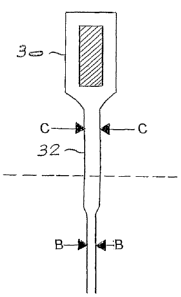Some of the information on this Web page has been provided by external sources. The Government of Canada is not responsible for the accuracy, reliability or currency of the information supplied by external sources. Users wishing to rely upon this information should consult directly with the source of the information. Content provided by external sources is not subject to official languages, privacy and accessibility requirements.
Any discrepancies in the text and image of the Claims and Abstract are due to differing posting times. Text of the Claims and Abstract are posted:
| (12) Patent: | (11) CA 2617643 |
|---|---|
| (54) English Title: | AN ELECTRODE AND A METHOD FOR FORMING AN ELECTRODE |
| (54) French Title: | ELECTRODE ET SON PROCEDE DE FORMATION |
| Status: | Deemed expired |
| (51) International Patent Classification (IPC): |
|
|---|---|
| (72) Inventors : |
|
| (73) Owners : |
|
| (71) Applicants : |
|
| (74) Agent: | BLAKE, CASSELS & GRAYDON LLP |
| (74) Associate agent: | |
| (45) Issued: | 2012-11-13 |
| (86) PCT Filing Date: | 2006-07-28 |
| (87) Open to Public Inspection: | 2007-02-08 |
| Examination requested: | 2009-11-20 |
| Availability of licence: | N/A |
| (25) Language of filing: | English |
| Patent Cooperation Treaty (PCT): | Yes |
|---|---|
| (86) PCT Filing Number: | PCT/IB2006/002065 |
| (87) International Publication Number: | WO2007/015131 |
| (85) National Entry: | 2008-02-01 |
| (30) Application Priority Data: | |||||||||
|---|---|---|---|---|---|---|---|---|---|
|
A method of forming an electrode includes casting a molten metal in a mould to
form an electrode with a header portion and a blade portion. The blade portion
of the electrode is then rolled after it has been cast. The blade portion may
be rolled into at least two different thicknesses. In one embodiment the metal
is lead or lead alloy and the method relates to the forming of a lead or lead
alloy anode.
L'invention concerne un procédé de formation d'électrode consistant à couler un métal fondu dans un moule afin de former une électrode qui comprend une partie rectangulaire et une partie lame. Ladite partie lame de l'électrode est ensuite roulée une fois qu'elle a été coulée. Elle peut être enroulée selon au moins deux épaisseurs différentes. Dans un mode de réalisation, le métal est du plomb ou un alliage de plomb et le procédé concerne la formation d'une anode en plomb ou en alliage de plomb.
Note: Claims are shown in the official language in which they were submitted.
Note: Descriptions are shown in the official language in which they were submitted.

For a clearer understanding of the status of the application/patent presented on this page, the site Disclaimer , as well as the definitions for Patent , Administrative Status , Maintenance Fee and Payment History should be consulted.
| Title | Date |
|---|---|
| Forecasted Issue Date | 2012-11-13 |
| (86) PCT Filing Date | 2006-07-28 |
| (87) PCT Publication Date | 2007-02-08 |
| (85) National Entry | 2008-02-01 |
| Examination Requested | 2009-11-20 |
| (45) Issued | 2012-11-13 |
| Deemed Expired | 2022-07-28 |
There is no abandonment history.
| Fee Type | Anniversary Year | Due Date | Amount Paid | Paid Date |
|---|---|---|---|---|
| Application Fee | $400.00 | 2008-02-01 | ||
| Maintenance Fee - Application - New Act | 2 | 2008-07-28 | $100.00 | 2008-02-01 |
| Maintenance Fee - Application - New Act | 3 | 2009-07-28 | $100.00 | 2009-07-24 |
| Request for Examination | $800.00 | 2009-11-20 | ||
| Maintenance Fee - Application - New Act | 4 | 2010-07-28 | $100.00 | 2010-06-01 |
| Maintenance Fee - Application - New Act | 5 | 2011-07-28 | $200.00 | 2011-05-10 |
| Maintenance Fee - Application - New Act | 6 | 2012-07-30 | $200.00 | 2012-07-10 |
| Final Fee | $300.00 | 2012-08-15 | ||
| Maintenance Fee - Patent - New Act | 7 | 2013-07-29 | $200.00 | 2013-06-12 |
| Maintenance Fee - Patent - New Act | 8 | 2014-07-28 | $200.00 | 2014-07-09 |
| Maintenance Fee - Patent - New Act | 9 | 2015-07-28 | $200.00 | 2015-07-08 |
| Maintenance Fee - Patent - New Act | 10 | 2016-07-28 | $250.00 | 2016-07-06 |
| Maintenance Fee - Patent - New Act | 11 | 2017-07-28 | $250.00 | 2017-07-05 |
| Maintenance Fee - Patent - New Act | 12 | 2018-07-30 | $450.00 | 2018-10-17 |
| Maintenance Fee - Patent - New Act | 13 | 2019-07-29 | $450.00 | 2019-08-07 |
| Maintenance Fee - Patent - New Act | 14 | 2020-07-28 | $250.00 | 2020-07-08 |
| Maintenance Fee - Patent - New Act | 15 | 2021-07-28 | $459.00 | 2021-07-07 |
Note: Records showing the ownership history in alphabetical order.
| Current Owners on Record |
|---|
| MEYER, THOMAS JOHN |
| TURNER, JOHN THOMAS |
| Past Owners on Record |
|---|
| None |